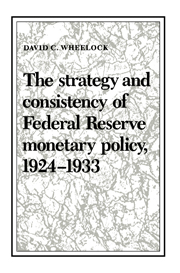Book contents
- Frontmatter
- Contents
- List of Figures
- List of Tables
- Preface
- 1 Introduction
- 2 The objectives of monetary policy, 1924–1933
- 3 Member-bank borrowing and the Fed's policy strategy
- 4 Policy disagreements within the Federal Reserve System: the effects of institutional change
- 5 Conclusion
- Appendix: Variable definitions and data sources
- References
- Index
4 - Policy disagreements within the Federal Reserve System: the effects of institutional change
Published online by Cambridge University Press: 11 September 2009
- Frontmatter
- Contents
- List of Figures
- List of Tables
- Preface
- 1 Introduction
- 2 The objectives of monetary policy, 1924–1933
- 3 Member-bank borrowing and the Fed's policy strategy
- 4 Policy disagreements within the Federal Reserve System: the effects of institutional change
- 5 Conclusion
- Appendix: Variable definitions and data sources
- References
- Index
Summary
[G]o back to 1927 when the last great open-market blunder was made by the Federal Reserve System. … It was an operation that was initiated, proposed, and developed by the Federal Reserve Bank of New York. … I doubt whether, if the Federal Reserve Board at that time had been clothed with the exclusive power [over open-market policy], … the Board would have dared to venture upon that operation.
Adolph Miller (United States Senate 1935, p. 689)The preceding chapter concludes that Federal Reserve policy during the Great Depression was largely predictable from the Fed's statements and actions during the 1920s. Thus, it suggests that the organizational changes stressed by Friedman and Schwartz (1963) – Benjamin Strong's death and reorganization of the Open Market Committee – played only a minor role in the System's mistakes during the depression. Nevertheless, it is true that during the depression officials of the Federal Reserve Bank of New York often proposed more expansionary actions than were accepted by the rest of the System. While it is certainly not clear that the Fed would have acted with sufficient vigor to halt the depression and promote recovery, monetary policy would undoubtedly have been more responsive had New York retained its leadership position.
This chapter studies the disagreements within the Federal Reserve System in order to better understand the impact of organizational changes on policy during the depression.
- Type
- Chapter
- Information
- Publisher: Cambridge University PressPrint publication year: 1991



